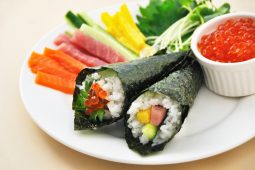Oden is a traditional hotpot dish served in autumn and winter consisting of varied ingredients stewed in a light soy-based dashi broth. The actual ingredients consist of some essential items such as boiled egg, thick slices of daikon radish, jellied konnyaku, deep fried atsu-age tofu, and tube-shaped chikuwa fish cakes, and also some other items that will differ according to the region or personal preference. Most people like to eat each item with a little miso sauce or a dab of karashi mustard, to give the savory flavours an extra kick. As you can probably imagine, oden is a simple dish, and easy to make, but it is also a super tasty and satisfying meal, warming both body and soul, and adding some cheer to even the darkest and coldest winter days.
Historians trace the origins of oden back to the 14 th century when grilled tofu was served with miso paste as a dish called dengaku. This gradually evolved into a skewered grilled snack of more varied ingredients called yaki-dengaku which was served with miso paste, and a stewed variety called nikomi-dengaku. Modern oden is derived from the latter dish which was sold from street stalls in 18th century Edo (modern-day Tokyo), but today it is popular all over the country with many regional variations. If you are lucky enough to be invited to a Japanese family home in the winter months, then you may be served oden, but it is still available from street-side stalls, especially during winter festivals, most casual izakaya restaurants will serve it, and you may also be able to find some small specialist oden restaurants. The one place where you can definitely find oden though, is at your local convenience store. Come the autumn, convenience stores across the country will have big metal pots not too far from the register, filled with stewing ingredients. Simply ask the staff for your favorite items from the selection on offer and a cheap, simple oden meal is yours!
Everybody has their favorite oden ingredients of course. According to yearly rankings from convenience stores across the country, daikon radish is regularly listed as the nation’s number one favorite. It is certainly a healthy vegetable with plenty of fiber, minerals and vitamin C to stave off the winter chills, and it nicely soaks up the flavours in the broth. Personally I am rather partial to the subtle flavor of hanpen — soft white, fluffy pillows made from processed Alasakan pollock. Mochi-kinchaku is another favorite — a delicious pouch made of abura-age (thinly sliced fried tofu) with the wonderful surprise of a sticky mochi rice cake inside. The item I always save till last though, is the yude-tamago or boiled egg. It doesn’t sound like much, but the egg also soaks up those savory dashi flavors and with plenty of karashi — the taste is magical.
However, depending on your location in Japan, the ingredients will differ to some extent. Potato is a popular addition in the western Kansai region, but not so common in eastern Kanto where musubi-konbu (kelp tied into a ribbon) is a particular favorite. A large, round, fried fishcake called satsuma-age is common in Kyushu, whereas processed fish dumplings, called tsumire, are more popular in the eastern regions. In northern Japan, (Tohoku and Hokkaido), shellfish such as whelks and scallops are a more common ingredient and a lighter broth is preferred, with each ingredient dipped into a separate miso sauce. In Nagoya, on the other hand, the broth is made from miso and the dip is soya sauce. The people of Shizuoka prefer a darker broth made with beef stock and all the ingredients are on skewers. While in warmer Okinawa you may be served oden in a cold pork broth with pigs’ trotters as one of the ingredients.
Additional flavorings on offer in convenience stores also differ across the nation. Karashi mustard, miso sauce, and yuzu-koshou (a mixture of citrus peel, peppers and salt) are commonly available across the country. But only in the island of Shikoku and the Chugoku region are you likely to find karashi and miso mixed together. In Kansai there may be soy sauce mixed with ginger, and in Tohoku there may well be ginger in the miso sauce.
Wherever you may wander in Japan, a hot steaming bowl of oden will brighten up the winter months and add a rosy glow to your cheeks. Most supermarkets stock easy-to-prepare oden kits, so why not try making it yourself?








